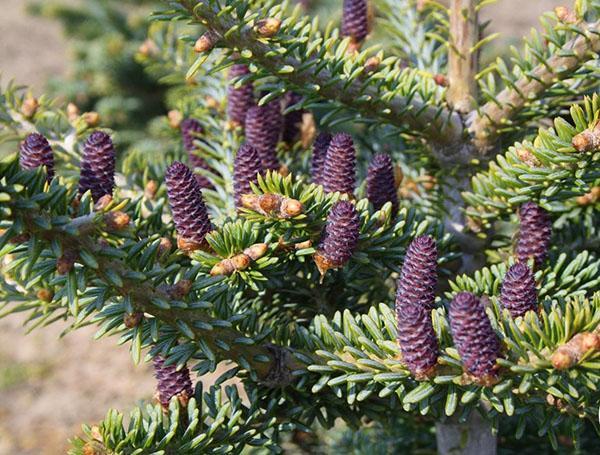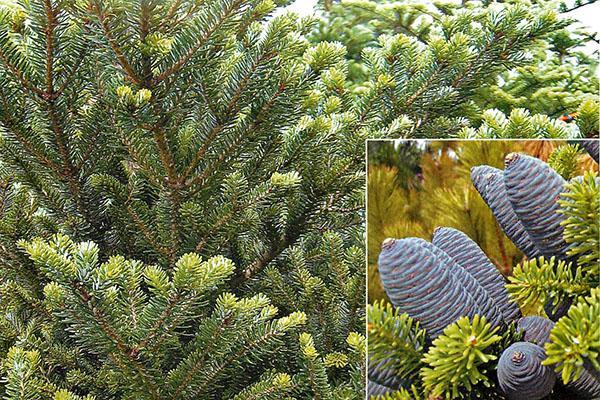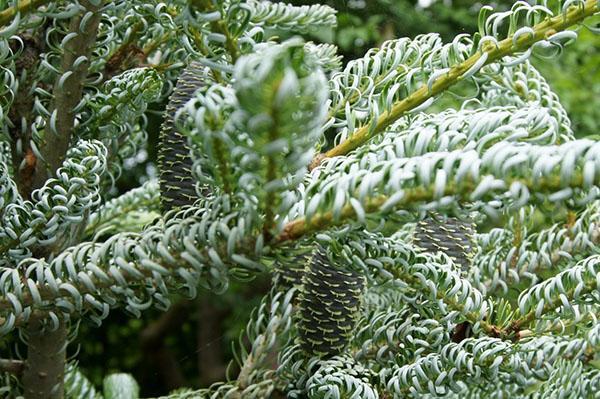What is the difference between planting and caring for Korean fir at their summer cottage
 The desire to decorate your site with fir is always justified. A cone-shaped, dense crown, large cones of saturated shades, juicy green needles, a harmonious combination with deciduous trees and shrubs, a pleasant aroma - this is only part of the advantages of coniferous plantations. But planting and caring for Korean fir requires certain knowledge, which a novice gardener cannot do without.
The desire to decorate your site with fir is always justified. A cone-shaped, dense crown, large cones of saturated shades, juicy green needles, a harmonious combination with deciduous trees and shrubs, a pleasant aroma - this is only part of the advantages of coniferous plantations. But planting and caring for Korean fir requires certain knowledge, which a novice gardener cannot do without.
Korean fir varieties
Before deciding on the choice of Korean fir, you should learn more about each variety, its properties, preferences and necessary conditions for growth.
The most popular varieties of coniferous wood include:
- Korean fir Molly. Planting and caring for it will not bring much trouble, it does not require too frequent watering, it grows well in lighted, windless areas. The tree is planted away from buildings and other plantings. The bright green, dense cone-shaped crown of an adult fir can reach 7 m in height and 3 m in diameter. Cones are attractive blue-violet in color, grow no more than 5 cm in length.

- Korean fir Silberlock. Planting and caring for this variety will bring real pleasure to landscape design lovers. Moderate watering, high winter hardiness, decorative appearance of needles are part of the advantages of Silberlok. The dark green, conical, "curly" crown of an adult plant reaches 5 m in height, grows up to 12 cm in a year. The cones are of a violet-green hue, 7 cm long. Before planting fir, you need to pay attention to the soil, it must be quite loose and acidic ... The tree prefers light, windless places.

- Korean fir Blue Emperor. Compact decorative tree. Unlike previous varieties, it is considered undersized. A silvery-violet, short, dense, soft crown grows 6 cm in a year and stops growing when it reaches a height of one and a half meter. Small buds are dark purple or blue in color. Fir is not demanding to the conditions, it takes root well in shady areas with moist soil.

- Korean Fir Diamond. The description of the variety should start with the dimensions. This tree is considered dwarf and grows no more than half a meter in height and seventy centimeters in width. The dense dark green soft crown at the top and pale blue at the bottom will be a worthy decoration for rocky gardens. There are no cones on the tree. The care is not whimsical, but it takes root only in light, windless places with slightly acidic, loose soil.

All these varieties take root well in our climate.
In the Moscow region, Korean fir will take root better and faster if you take a seedling in local nurseries, where the tree has already got used to and adapted to the climate.
Planting and caring for Korean fir: features
 In order for the cultivation of fir to be enjoyable, and it becomes a real decoration of the site, you should know some of the characteristic features of this tree.
In order for the cultivation of fir to be enjoyable, and it becomes a real decoration of the site, you should know some of the characteristic features of this tree.
First of all, you need to correctly determine the landing site. Considering that the tropics and subtropics are the historical homeland of coniferous trees, the best option would be a well-lit, windless area with loose soil. Young seedlings are especially demanding, even a light shade and draft can be fatal for them. Therefore, it is not recommended to plant them close to other large plantings and buildings.
The tree does not tolerate transplants. Therefore, when choosing a place for planting, one should take into account in advance that the roots of the fir grow not in depth, but in breadth, and are located close to the surface of the earth. This makes any planting near an adult tree impossible.
The soil composition does not play a decisive role in choosing a planting site. Fir can independently saturate even the poorest, loamy soil with nutrients. But sandy, light, nutritious soils will help accelerate the adaptation of the seedling. Avoid marshy areas and lowlands where melt water collects in spring. In the absence of other options, you need to take care of good drainage in advance.
How to plant Korean fir
 When the place for the seedling is determined, you can start planting. This must be done before buds and shoots appear. The optimal disembarkation time is March, April.
When the place for the seedling is determined, you can start planting. This must be done before buds and shoots appear. The optimal disembarkation time is March, April.
Korean fir is a winter-hardy tree. For a seedling to survive its first winter, it must be four to ten years old at the time of planting.
Prepare a hole for a seedling taking into account the characteristics of the variety. The larger the crown of an adult tree, the larger the pit. The average depth is seventy centimeters. At the bottom there is a drainage system made of broken bricks and sawdust.
 Before placing the seedling in the hole, you need to mix one part of the dug soil with half of the peat and humus. Pour the mixture into the pit and leave to shrink. Then gently spread the roots of the tree, place in the planting hole and sprinkle with earth. For watering after disembarkation, at least two buckets of water and near-stem mulch are required.
Before placing the seedling in the hole, you need to mix one part of the dug soil with half of the peat and humus. Pour the mixture into the pit and leave to shrink. Then gently spread the roots of the tree, place in the planting hole and sprinkle with earth. For watering after disembarkation, at least two buckets of water and near-stem mulch are required.
No need to deepen the roots of the tree. They must be close to the surface of the earth, otherwise the fir may die.
When planting two or more Korean fir seedlings, it is recommended to maintain a distance between the holes of at least five meters for single plantings or two meters if you wish to create hedge.
Care rules
 The following will help maintain the health and decorative appearance of the plantingKorean fir care tips:
The following will help maintain the health and decorative appearance of the plantingKorean fir care tips:
- Regular, abundant watering. Without enough moisture, the crown will become sparse and unsightly.
- Top dressing and timely treatment from pests.
- Pruning.
Watering fir planted in open ground will differ from container planting. In the second case, more and more water is required. In the first two weeks after planting, the seedlings should be watered every day, regardless of where they are grown. An adult tree needs abundant watering three times during the growing season. In especially hot and dry summers, it is better to play it safe and provide the fir with moisture at least twice a month.
 For better preservation of moisture in the soil, the periosteal circle should be abundantly mulch and loosen after each watering.
For better preservation of moisture in the soil, the periosteal circle should be abundantly mulch and loosen after each watering.
It is better to mulch the soil with sawdust or needles treated against infections.
Fir is not demanding for fertilizers. The first top dressing is three years after planting. It is better to use specialized products in the proportions indicated by the manufacturer.
Pruning the crown of the tree is optional. It is carried out solely for the purpose of maintaining the decorative effect of the fir. The main thing is to remove dried fragments in time.
Pest control

Juicy, dense needles are vulnerable to pests and diseases. Some of the most common problems that gardeners face include:
- Aphid. It is characterized by a whitish bloom. The affected areas of the crown should be removed and the planting should be sprayed with preparations with insecticidal properties.
- Fungus. It can occur in places where wood was cut. Specialized biologics for conifers will help to cope.
- False shield. The affected plantation changes color to brown and dries up. On the needles, honey drops of moisture are noted. For the prevention and treatment of the disease, it is recommended to cover the fir in spring with burlap, pre-treated with glue against insects.
- Spider mite. Typical signs are cobwebs, yellow spots on the needles, shedding of needles.To prevent the disease, spraying with cold water is recommended in the morning or evening. Treat with infusions of garlic or dandelion.
When the first signs of infection of a coniferous tree appear, you should immediately start processing. This will help save the tree from total destruction.
Fir in landscape design
 Coniferous plantings will become a real decoration of any site. They are used in flower beds, alpine slides, stone gardens and rockeries. Different shades of needles go well with each other, emphasizing each other favorably.
Coniferous plantings will become a real decoration of any site. They are used in flower beds, alpine slides, stone gardens and rockeries. Different shades of needles go well with each other, emphasizing each other favorably.
 With the help of group plantings, you can zone open areas, organize hedges near gazebos, resting places. Combined with deciduous fir stands, they create beautiful compositions.
With the help of group plantings, you can zone open areas, organize hedges near gazebos, resting places. Combined with deciduous fir stands, they create beautiful compositions.
 Knowing the rules of pruning, coniferous plantings can be given any shape, such a tree will become an object of attention and admiration.
Knowing the rules of pruning, coniferous plantings can be given any shape, such a tree will become an object of attention and admiration.
 Dwarf varieties go well with deciduous shrubs, thujas, flowers.
Dwarf varieties go well with deciduous shrubs, thujas, flowers.
 Korean fir is distinguished by its longevity. And it depends only on the correct planting and care whether it will become a chic decoration of the site or turn into an unsightly tree that occupies a large area.
Korean fir is distinguished by its longevity. And it depends only on the correct planting and care whether it will become a chic decoration of the site or turn into an unsightly tree that occupies a large area.